Chapter 5 flashcards
1/56
There's no tags or description
Looks like no tags are added yet.
Name | Mastery | Learn | Test | Matching | Spaced |
|---|
No study sessions yet.
57 Terms
What is the equation for an exponential function?
what is f(x)= b^x
What is the “b” term of f(x)=b^x
What is the base of the function
what is the “x” term of f(x)=b^x?
What is the exponent?
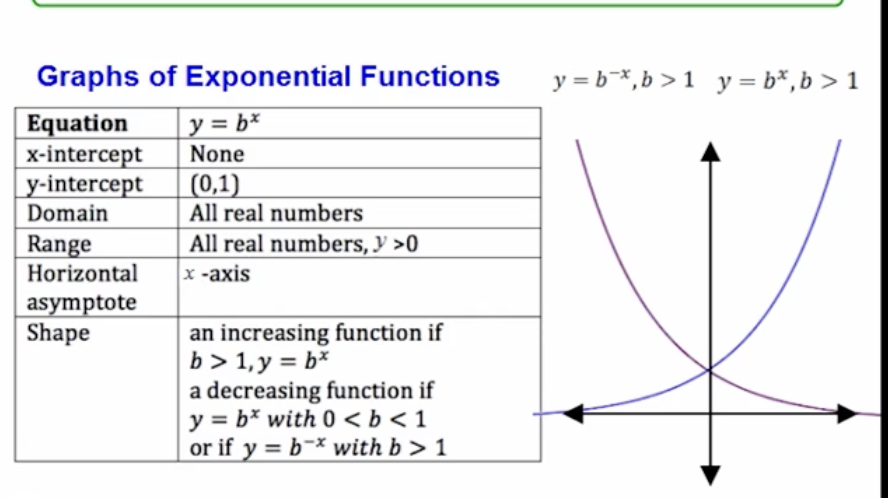
Do exponential functions have an x-intercept?
No.
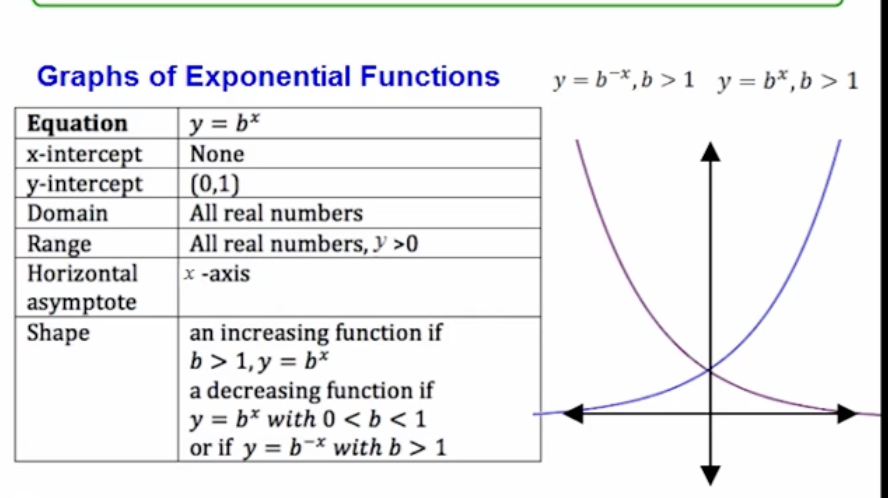
What is the asymptote of this?
The x-axis, it is reaching but will never touch the x-axis
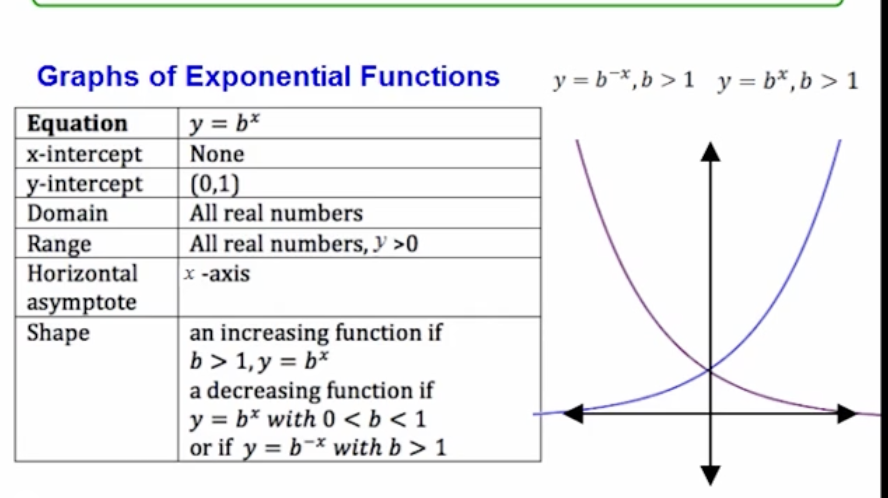
What does the blue line represent?
An increasing function, b>1
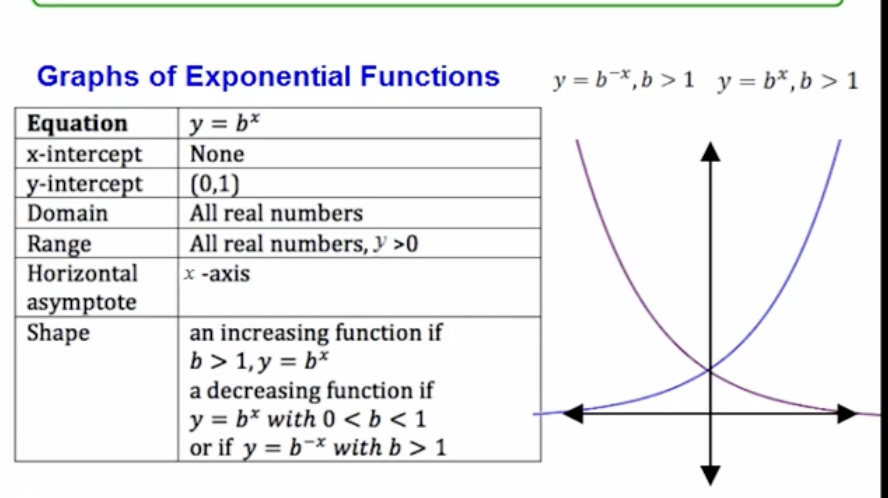
What does the purple line represent ?
A decreasing function, 0<b<1.
If the graph of y=b^x has been shifted up or down, what happens with the horizontal asymptote?
It will shift up or down accordingly, reflecting the new position of the graph.
From the graph y=2^x → 2^x +3, what happens with the horizontal asymptote?
The horizontal asymptote will shift up to y=3.
Again, what us ab exponential growth function?
An exponential growth function is a mathematical expression of the form y = a(b^x) where a > 0 and b > 1, indicating that the value of y increases rapidly as x increases.
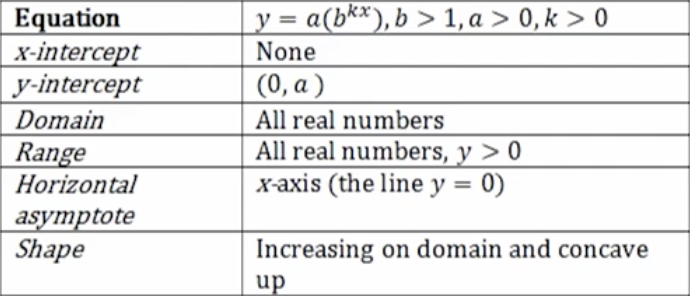
What is the y-intercept of an exponential growth function?
Whatever the a value is.
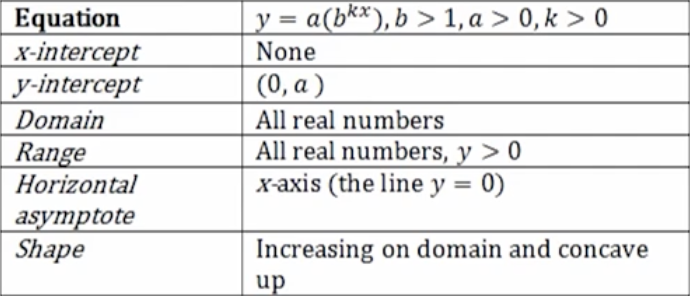
What is the horizontal asymptote of an exponential growth function?
The x-axis with the line y=0
What is the equation for a future value of investment that compounds interest annually?
What is S=P(1+r)^t
What are exponential decay functions?
y=a(b^kx), where b is less than 1
What is the equation of a future value of investments that compounds interest continuously?
S=Pe^rt
This is the logarithmic form
What is logb(a)=c?
This is the exponential form
What is b^c=a?
Log2(8)=3 into Exponential
This means 2^3=8.
Log5(25)=2 into exponential
5²=25
Log3(81)=4 into exponential
3^4=81
Log10(1000)=3 into exponential
10^3=1000
2³=8 into Log form
Log2(8)=3
3^4=81 into a log
Log3(81)=4
7²=49 into a log
Log7(49)=2
y=log(b)x: when b>1 . . .
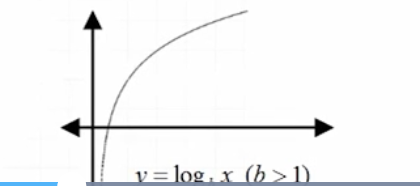
y=log(b)x : when (0<b<1)
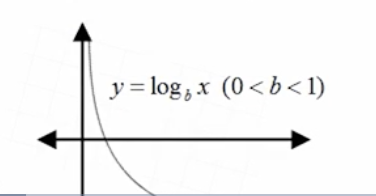
3^-2=1/9 into a log
Log3(1/9)=-2
Log2(32)=5 into
2^5=32
The () and = have a
Relationship when converting between exponential and logarithmic forms.
What is the base of this log: Log(10,000)?
The base of the logarithm is 10, indicating that 10 is raised to a power to yield 10,000.
Log10(10,000)=x into exponential and solve
10^x = 10,000
x=4
This is a logarithm function with base e
and is known as the natural logarithm, often represented as ln(x).
basic properties of logs: when logb(B)=
1
Basic properties of logs: when logb(1)=
0
Basic properties of logs: when logb(b)^x=
x
Basic properties of logs: when M and N are the same then.
logb(M) = logb(N)
What is the product property of logs
logb(MN) = logb(M) + logb(N)
what is the quotient property of logs?
logb(M/N) = logb(M) - logb(N)
What is the power property of logs?
logb(M)^k= klogb(M)
This is the change of base formula:
loga(x)= logb(x) / logb(a)
Solve 5=2^x
1st) log(5)=log(2)^x
log5= xlog(2)
2nd) x = log(5) / log(2)
x= log5/logs2 (evaluate)
Solve log2(x)=-5
2^-5=x
x=1/2^5= 1/32
What is the equation for an exponential growth function?
y=a(1+r)²
What is the equation for an exponential decay function?
y=a(1-r)²
Compounded annually means . . .
Interest that is added to an account at the end of each year
What is the equation for finding future value of an investment that is compounded annually?
S=P(1+r)^t
If $1000 is invested at 5% interest compounded annually for 7 years, what is the future value of investment?
S=1000(1+.05)^7= $1407.10
What is the equation for finding the future value of an investment with periodic compounding?
S=P(1+r/k)^kt
where k is the number of compounding periods per year.
What is the equation for finding the future value of an investment with continuous compounding?
S=Pe^rt
If $1000 is invested at 5% interest compounded continuously for 7 years, what is the future value of the investment?
S=1000e^(.05)(7)= 1419.07
What is the equation for finding the present value
P=s(1+i)^-n
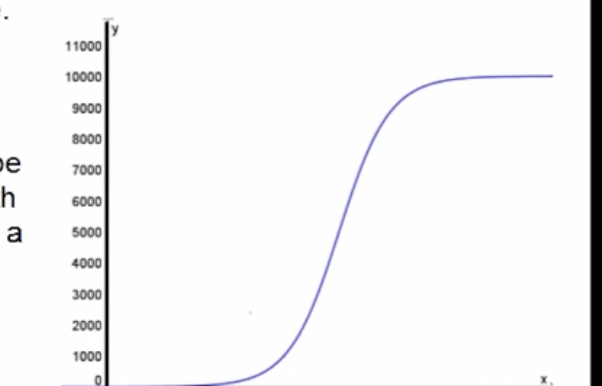
These are functions that grow slowly, increase at a rapid rate, and finally slow over time to a rate that is almost zero. “S-shaped curve”
What are logistic functions?
What is the equation of a logistic function?
what is f(x)= c/1+ae^-bx?
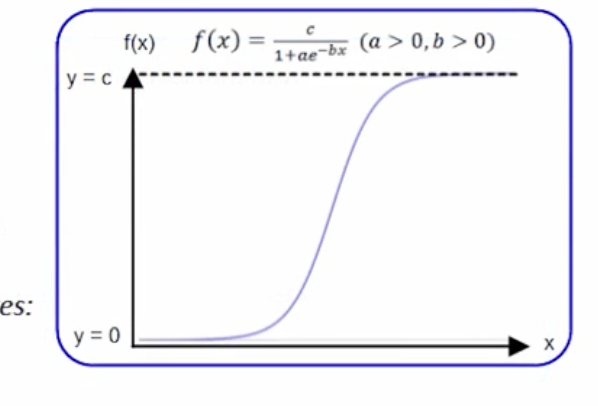
What are logistic growth functions?
a>0 and b>0
Horizontal asymptote: y=c
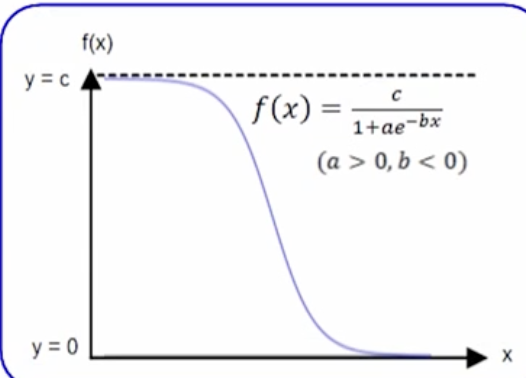
What are logistic decay functions?
a>0 but b<0
This are a type of function that models rapid growth and eventually levels off, describing human growth and the development of growth of organizations
What are Gompertz functions ?
What is the equation of a Gompertz function?
N=Ca^R^t
t= time
R= rate of growth
maximum possible number of individuals
a= proportion of C